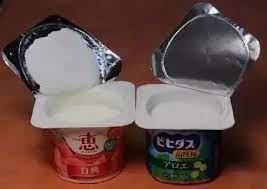Source:Link Testing Instruments Co.,Ltd.

Yogurt is a milk product that is made of fresh milk, pasteurized and then added beneficial bacteria (starter) to the milk. After fermentation, it is cooled and filled. The fermentation process makes the sugar and protein in the milk rich. About 20% are hydrolyzed into small molecules. After fermentation, the fatty acids in milk can be doubled compared to raw milk. These changes make yogurt easier to digest and absorb. The high protein and fat content of yogurt determines that it is more sensitive to oxygen. Therefore, in order to ensure the shelf life of yogurt, yogurt in plastic cups is usually sealed with a composite film with a metal material such as aluminum foil as the cover film. The composite fastness between the single-layer films of the lidding film is low, that is, the peel strength of each single-layer film is low, and when the lidding film is torn off, it is easy to see that the lidding film and the cup are not separated, but the lidding film is not separated. The phenomenon of the separation of the sticking places of each single-layer film not only brings inconvenience to consumers, but also causes the decline of corporate image. Therefore, all food companies should strengthen the composite fastness testing of lidding film materials.
Test methods and instruments
The testing process of the peel strength of the composite film is carried out according to the standard GB 8808 "Peeling Test Method for Soft Composite Plastic Materials". The testing equipment used in the peel strength test is a tensile testing machine. The testing equipment used in this article is LTS-05 intelligent electronic tensile testing machine independently developed and produced by Link Testing.
Test principle: Peel strength characterizes the force value required to peel off the two monolayer films that are composited together. The test equipment includes upper and lower fixtures. The upper fixture is a moving fixture, which can move up and down along the equipment according to the set test speed, and is equipped with a force sensor, and the lower fixture is a fixed and static fixture. During the test, the two layers of film in the pre-peeled section are clamped on the upper and lower chucks respectively, and the unpeeled end of the sample is peeled off by the upward movement of the upper chuck. the force value.
Test samples and test procedures
Test sample: composite film material for a certain brand of yogurt lidding film in cups.
Experimental procedure:
(1) Use a sampler to cut 5 samples each with a width of 15 mm and a length of 200 mm from the horizontal and vertical directions of the cover film sample.
(2) Manually peel about 50 mm from one end of the 10 samples.
(3) Clamp the two ends of the peeled part of the sample with the upper and lower clamps of the equipment respectively, so that the long axis direction of the sample coincides with the center line of the two clamps.
(4) Set the test parameters such as displacement and test speed, and click the test start option to start the test.
(5) The equipment automatically tests and records the force value during the peeling process of the sample, and reports the final test result after the test.
Test Results and Analysis The average transverse peel strength of the samples tested in this paper is 4.412 N/15mm, and the average longitudinal peel strength is 5.944 N/15mm. The LTS-05 intelligent electronic tensile testing machine is used to test the composite fastness of the cover film for yogurt cups. It has the characteristics of simple operation, high repeatability and accuracy of the test results, and can truly reflect the composite fastness of the lidding film.
For more details please visit www.linktesting.org